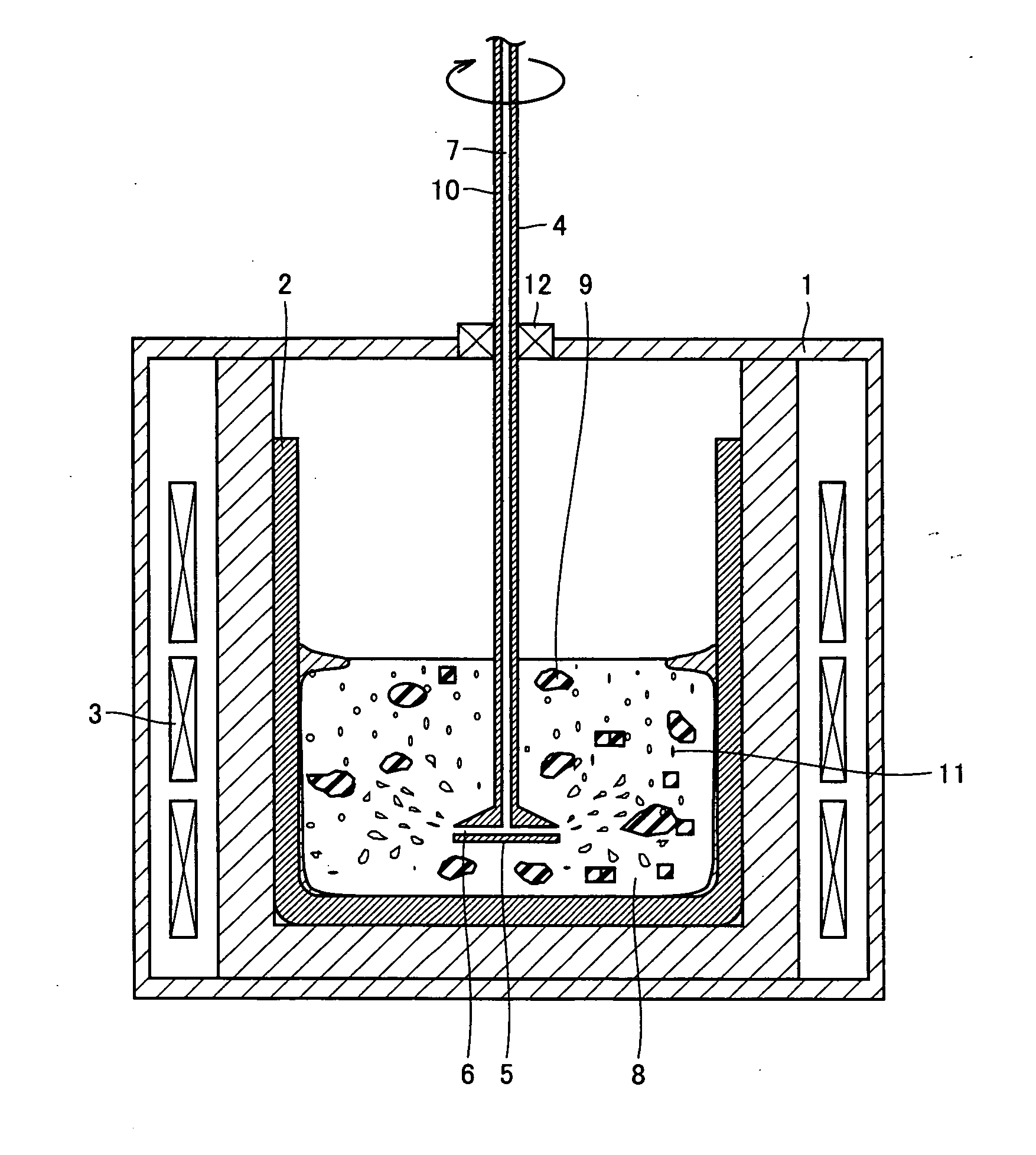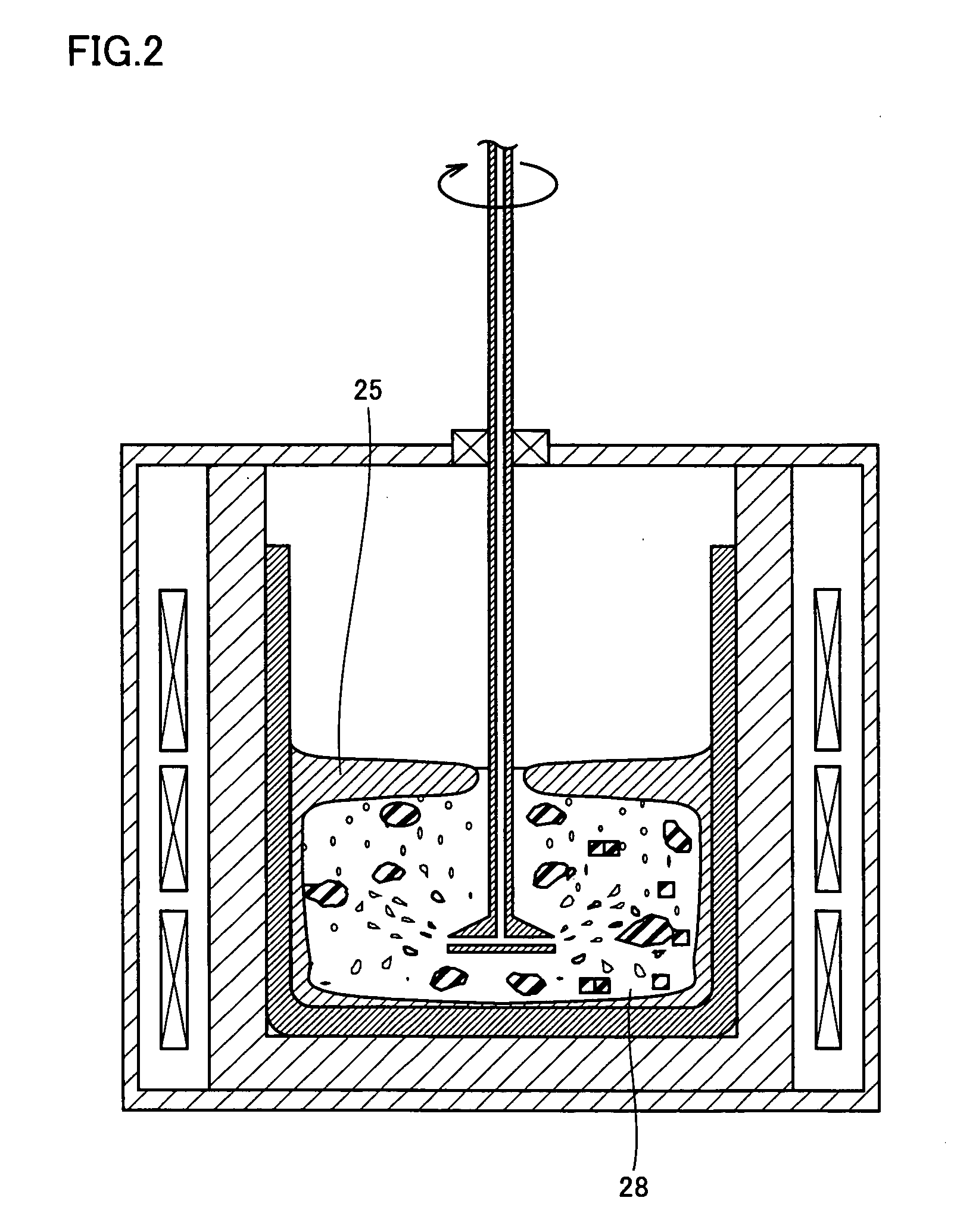Method For Refining Silicon And Silicon Refined Thereby
a technology of silicon refining and silicon refined by means of silicon, which is applied in the direction of silicon compounds, chemistry apparatus and processes, inorganic chemistry, etc., can solve the problems of inability to efficiently perform solidification segregation of boron, inability to reduce the rate of removal of impurities, and complex manufacturing plants and greater energy. , to achieve the effect of simple refining process, efficient removal from molten materials, and low energy consumption
- Summary
- Abstract
- Description
- Claims
- Application Information
AI Technical Summary
Benefits of technology
Problems solved by technology
Method used
Image
Examples
example 1
[0056] In the present example, 1 kg of MG-Si was placed in crucible 2 in FIG. 1. Then, silicon oxide powder, lithium silicate powder and calcium silicate powder were mixed and placed in crucible 2 by an amount corresponding to 20 mass % of MG-Si. Silicon oxide powder, lithium silicate powder and calcium silicate powder were converted to be silicon oxide:lithium oxide:calcium oxide=67:16:17 (mass ratio) and blended. Next, the inside of smelting furnace 1 was set to be Ar atmosphere of 0.10 MPa, and crucible 2 was heated using electromagnetic induction heating apparatus 3 thereby melting MG-Si, which was held at 1550° C. For measuring the boron content before processing, molten silicon 8 was extracted by about 20 g, and 5 g of which was used for measurement.
[0057] As the refine gas, a gas in which, relative to a carrier gas constituted of a mixture gas of Ar and hydrogen (the volume ratio of hydrogen being 4%), water vapor was blended by 60 volume % was used. The refine gas was intro...
second example
[0059] The refine process was carried out similarly to the first example, except that the process gas containing only Ar was employed for the purpose of clarifying the effect of hydrogen in the process gas. The result is shown in FIG. 3. As shown in FIG. 3, in the present example where hydrogen is not added to the process gas, boron removal was carried out efficiently without lowering boron removal rate, although the boron concentration was slightly higher as compared with the first example.
third example
[0060] In the present example, the refine process was carried out similarly to the first example, except that the composition of the refine additive was changed. As the refine additive, silicon oxide powder and lithium silicate powder were converted to be silicon oxide:lithium oxide=80:20 (mass ratio) and blended. The result is shown in FIG. 3. As shown in FIG. 3, the boron concentration was slightly higher as compared with the first example. The reason was assumed as follows. Since the refine additive of silicon oxide:lithium oxide=80:20 (present example) was lighter in specific gravity than the refine additive of silicon oxide: lithium oxide:calcium oxide=67:16:17 (the first example), the molten slag tended to float over the melt surface and the vaporizing removal rate of the boron oxide was lowered as compared with the first example. However, by performing the process gas blow-in process, boron removal was efficiently achieved without lowering the boron removal rate.
PUM
| Property | Measurement | Unit |
|---|---|---|
| melting point | aaaaa | aaaaa |
| temperature | aaaaa | aaaaa |
| mass % | aaaaa | aaaaa |
Abstract
Description
Claims
Application Information
 Login to View More
Login to View More - R&D
- Intellectual Property
- Life Sciences
- Materials
- Tech Scout
- Unparalleled Data Quality
- Higher Quality Content
- 60% Fewer Hallucinations
Browse by: Latest US Patents, China's latest patents, Technical Efficacy Thesaurus, Application Domain, Technology Topic, Popular Technical Reports.
© 2025 PatSnap. All rights reserved.Legal|Privacy policy|Modern Slavery Act Transparency Statement|Sitemap|About US| Contact US: help@patsnap.com



